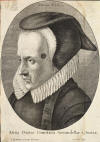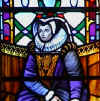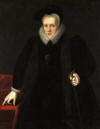


Anne DACRE
(C. Arundel)
Born: 21 Mar 1557, Carlisle
Died: 19 Apr 1630, Shiffnall, Shropshire, England
Buried: Arundel
Father: Thomas DACRE (4° B. Gillesland/3° B. Greystoke)
Mother: Elizabeth LEYBURNE (B. Dacre/D. Norfolk)
Married: Phillip HOWARD (1° E. Arundel) 1571
Children:
2. Thomas HOWARD (14º E. Arundel)
Oldest daughter and one of the heiresses of Thomas Dacre, Lord of Gillesland, by his second wife, Elizabeth Leyburne. Following the death of his husband, Lady Dacre remarried, 29 Jan 1567, Thomas Howard, 4º Duke of Norfolk, a matrimonial alliance aimed at securing the property of the great Dacre family for the Howards. The Duke and Lady Dacre were married and their little children married too. They were brought up by their stepfather, and by their grandmother, Helen Preston, dowager Lady Mounteagle.
In Sep 1571, when Anne was fourteen, was married to Phillip Howard, baron Greystoke and Earl of Arundel. He should have succeeded his father to the dukedom, but Thomas Howard was executed for treason in 1572 and the title was forfeit. Norfolk requested that “Meggy and Nan” — his daughter, Margaret Howard, and Anne — be given into the care of the Frances Sidney, Countess of Sussex. Phillip Howard was taken into the household of William Cecil, Lord Burghley, then attended St. John’s College, Cambridge, and then went to court. Phillip soon left his quiet, young wife for the glamour of Elizabeth's court, where he wasted their money and property to flatter the Queen. Anne was driven from her home and rumours came to her of infidelities of doubts cast on the validity of her marriage and always there was the indifference of Phillip and the contempt of the Court for her simple goodness. In 1581, Phillip succeeded to his maternal grandfather’s title as earl of Arundel and shortly thereafter he and Anne began to live together, part of the time at Arundel Castle.
This part of her pilgrimage lasted about eleven years. She became after her conversion the patroness of Father Southwell and of many priests, and eventually founded the novitiate of the Jesuits at Ghent. Then there was a brief togetherness with Phillip which had its own pain and dangers. Anne Dacre and Phillip's favorite sister, Margaret Sackville, were reconciled to the Catholic Church. When Anne openly converted to Catholicism, which was against the law, the Queen committed her to the custody of Sir Thomas Sherley at Wiston House. Anne returned to the full practice of her faith. She was successful in convincing her husband to convert to Catholicism as well, a step he took on 30 Sep 1584. Phillip was moved by the influence of Fr. Edmund Campion to seek reconciliation with the Roman Catholic Church. The Queen was furious with rage. As a result, he was made a prisoner in his own house by order of the Queen. He was released in Apr 1584 and Anne was allowed to leave Wiston in Sep. Anne had to bear her first child away from home, and, as part of a last, desperate appeasement by Phillip, the child was christened a Protestant and named Elizabeth.
Phillip however went boldly and rashly into his new convictions, and minds subtler than his duped him into treasonous plots. In April 1585, Phillip made secret plans to flee the country. Contrary winds delayed his escape and when he finally set sail, his ship was boarded and he was returned to shore. He was confined in the Beauchamp Tower, charged with trying to escape the realm. His brother William and sister Margaret and his uncle, Henry Howard, were also arrested.
Shortly after he was imprisoned, Anne gave birth to their son and heir, Thomas. Anne and her two children were reduced to living in one wing of Arundel House on a pension of £8 a week. She could not visit Phillip and the Queen ordered the gaoler to lie to Phillip that his second child was a girl, not the longed-for son and heir. All these years Anne could never see Phillip and, as he drew near to death, only by renouncing their faith would they be allowed to meet.
Anne managed, however, to scrape together £30 to bribe Cecily Hopton, one of the daughters of the Lord Lieutenant, to provide her husband with access to a priest, William Bennett, who was also imprisoned in the Tower of London. Bennett secretly said mass in Phillip’s cell until, in the autumn of 1588, they were discovered and Bennett was transferred to another prison.
On various occasions it was reported to his wife that the Earl was drinking in prison, that he had affairs with all kinds of loose women, and was entirely indifferent to religious concerns. Even where he was at the point of death in 1596, it was made a condition that he must renounce his faith if he wanted to see Anne and the children before he died.
From 1589 until 1595, Robert Southwell secretly lived in Anne’s household as her priest. Under James I, Anne regained possession of some of her properties, including Shifnal Manor, Shropshire, where she died. She spent her last years writing a memoir with the help of a live-in biographer. He finished it five years after her death.
Anne lived to 73 years of age, revered for good works. She was described in life as being "taller of stature than the common sort" and "somewhat corpulant" in her last years. Her last cross was the apostasy (during her lifetime) of her son Thomas, again for advancement at Court.
 to Bios Page
to Bios Page |
|
 to Peerage Page
to Peerage Page |
 to Home Page
to Home Page |